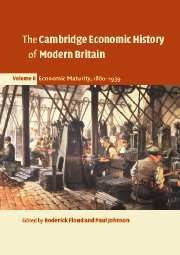Book contents
- Frontmatter
- 1 Long-run growth
- 2 Population and regional development
- 3 Human capital and skills
- 4 Manufacturing and technological change
- 5 The service sector
- 6 Agriculture, 1860–1914
- 7 Trade, 1870–1939: from globalisation to fragmentation
- 8 Foreign investment, accumulation and Empire, 1860–1914
- 9 Enterprise and management
- 10 Domestic finance, 1860–1914
- 11 Living standards, 1860–1939
- 12 The British economy between the wars
- 13 Unemployment and the labour market, 1870–1939
- 14 British industry in the interwar years
- 15 Industrial and commercial finance in the interwar years
- 16 Scotland, 1860–1939: growth and poverty
- 17 Government and the economy, 1860–1939
- References
- Index
- References
10 - Domestic finance, 1860–1914
Published online by Cambridge University Press: 28 March 2008
- Frontmatter
- 1 Long-run growth
- 2 Population and regional development
- 3 Human capital and skills
- 4 Manufacturing and technological change
- 5 The service sector
- 6 Agriculture, 1860–1914
- 7 Trade, 1870–1939: from globalisation to fragmentation
- 8 Foreign investment, accumulation and Empire, 1860–1914
- 9 Enterprise and management
- 10 Domestic finance, 1860–1914
- 11 Living standards, 1860–1939
- 12 The British economy between the wars
- 13 Unemployment and the labour market, 1870–1939
- 14 British industry in the interwar years
- 15 Industrial and commercial finance in the interwar years
- 16 Scotland, 1860–1939: growth and poverty
- 17 Government and the economy, 1860–1939
- References
- Index
- References
Summary
AN IMPERFECT FINANCIAL MARKET?
At the opening of the twentieth century (Joseph 1911), it was implied that the financial sector had the face of Janus, a characterisation many historians have subsequently adopted and further developed. While the markets facilitated a mounting volume of foreign borrowing from the mid-1850s, domestic clients were, it has repeatedly been maintained, increasingly ill served, to the detriment of investment at home (see also chapter 8 above).
The charge laid against financial institutions largely relates to industrial finance (Saville 1961), and to the argument that an imperfect capital market primarily directed savings into overseas securities. These yielded less than 5 per cent immediately prior to the First World War, while total capital invested at home returned more than 10 per cent. This comparison, however, greatly overstates the apparent illogical bias in the financial sector’s workings, since much overseas investment comprised publicly marketed and fixed-interest bonds whereas a significant proportion of domestic returns was generated by privately held unsecuritised equity (McCloskey 1970: 451–5). When analogous domestic and overseas financial assets are compared, foreign securities either carried only somewhat higher coupons or distributed slightly greater dividends, reflecting the rather bigger risks that their ownership entailed (Cairncross 1953: 227–31); these risk and return relationships were confirmed by Edelstein (1976). He also found that, although returns on both home and overseas publicly issued securities fell secularly as their respective marketed volumes increased, during periods of domestic boom such as the mid-1890s, the small differential favouring foreign stocks diminished. However, when overseas investment began to mount again – as from 1897 – the ‘risk premium’ on comparable foreign securities once more increased.
- Type
- Chapter
- Information
- The Cambridge Economic History of Modern Britain , pp. 253 - 279Publisher: Cambridge University PressPrint publication year: 2004
References
- 5
- Cited by

